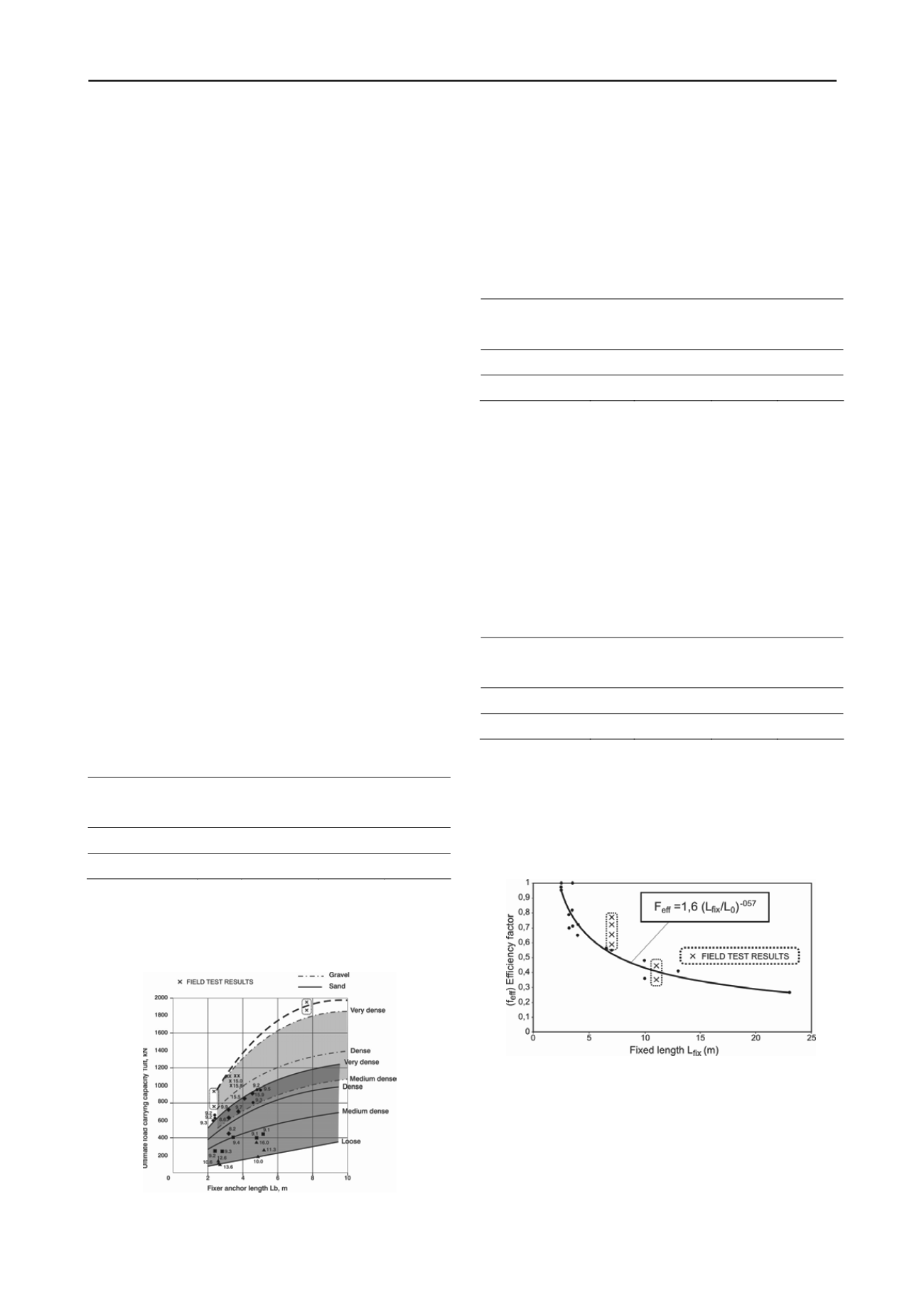
2121
Technical Committee 207 /
Comité technique 207
3
GENERAL FIELD TEST DETAILS
The results of full-scale field tests, undertaken to verify the
influence of the fixed anchor length on the ultimate capacity
(T
ult
) and the average bond stresses (τ
ault
) obtained at failure in
gravelly sands, silty clays and clayey marl are presented in this
chapter.
Investigation test were done according to the Test Method 1
(EN 1537), with incremental load cycles from a datum to
ultimate load. The test involved very strict measurement of
tendon displacement versus applied load and, at the peak of
each cycle, measurement of tendon displacement versus time.
Anchors subjected to investigation were high-pressure grouted,
designed to fail at grout/ground interface. Field tests were
carried out near previously performed boreholes to establish
better correlation between obtained data and soil characteristics.
Values of efficiency factor presented in Table 1, 2, 3 and 4
are calculated comparing average bond stresses (τ
ault
) of SBMA
units and conventional anchors, considering that units that
formed SBMA anchors with fixed length of 2.5 – 3.0 m were
short enough to avoid progressive debonding effects. Due to
that hypothesis it can be assumed that efficiency factor for
individual units of SBMA anchor have the value of 1.
To avoid possible influences and collaboration of the free
anchor length on pull-out capacity and bond stress distribution,
fixed units of all test anchors were separated by specially
designed compressible joints that prevent load transmission
from fixed to free anchor length.
3.1
Test results in gravelly sand
The trial anchors, six SMBA with two units (in total 12 units)
and two conventional anchors, were executed in dense to very
dense gravelly sand, with silt content that varied from 5 to 15%,
at depth of 20 to 30 m.
SBMA anchors were formed by two units of 2.5 m fixed
length, while conventional anchors had fixed length of 7.5 m.
Diameter of all test anchors was of 178 mm. The following
table shows ranges of obtained results:
Table 1. Test results for pressure grouted 178 mm diameter anchors in
gravelly sands.
Nº/Type of Anc.
L
fix
T
ult
τ
ault
f
eff
m
kN
kN/m
2
6 SBMA (12 units) 2.5
780–960
558-687
1
2 Conventional
7.5
1880-1920
445-455
0.65-0.8
It is worthy to mention that values of the obtained ultimate
load capacities are very consistent with Ostermayer and Scheele
(1978) diagrammatic presentations of the load capacity against
fixed length (see Figure 4).
Figure 4. Ultimate load capacity obtained in field test vs. values
proposed by Ostermayer and Scheele for sand and gravel (1977).
3.2
Test results in silty clays
Table 2 summarizes results for trial anchors, 2 SMBA with two
units (in total 4 units) and two conventional anchors, performed
in stiff silty clay (CL) at depth of 15 to 25 m. SBMA anchors
were formed by two units of 2.5 m fixed length, and
conventional anchors had fixed length of 8.0 m. Diameter of all
test anchors was of 160 mm.
Table 2. Test results for pressure grouted 160 mm diameter anchors in
silty clays.
Nº/Type of Anc.
L
fix
T
ult
τ
ault
f
eff
m
kN
kN/m
2
SBMA (4 units)
2.5
400–440
318-350
1
2 Conventional
8.0
915-950
227-236
0.65-0.74
3.3
Test results in clayey marl
The trial anchors were carried out in two different sites with
similar soil characteristics, stiff to very stiff clayey marl (CH-
CI), with sand proportion less than 10%.
3.3.1
Test site A
The trial anchors were constructed at depth of 20 m, with
diameter of 150 mm. SBMA anchors were formed by two units
of 3 m fixed length, and conventional anchors had fixed length
of 11 m.
Table 3. Test results for pressure grouted 150 mm diameter anchors in
layey marl – Test site A.
c
Nº/Type of Anc.
L
fix
T
ult
τ
ault
f
eff
m
kN
kN/m
2
2 SBMA (4 units)
3.0
450
318
1
2 Conventional
11.0
785
110-152
0.35-0.48
Results presented in Table 3 demonstrate high inefficacy of
fixed anchor lengths longer than 8 or 10 m.
Efficiency factor for 11 m long fixed length obtained
comparing average bond stresses varies from 0.35 to 0.48. It is
important to emphasize that results feet well with efficiency
factor values proposed by Barley (1995), as it can be seen in
Figure 5.
Figure 5. Efficiency factor obtained in field tests in silty clays and
clayey marlvs. values proposed by Barley (1995).
3.3.2
Test site B
The trial anchors were executed at depth of 30 to 35 m, with
diameter of 178 mm. SBMA anchors were formed by two and
three units of 2.5 and 3 m, while conventional anchors had fixed
length of 7.5 m.
Table 4. Test results for pressure grouted 178 mm diameter anchors in
clayey marl – Test site B.


